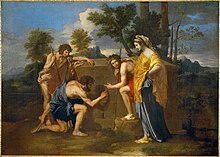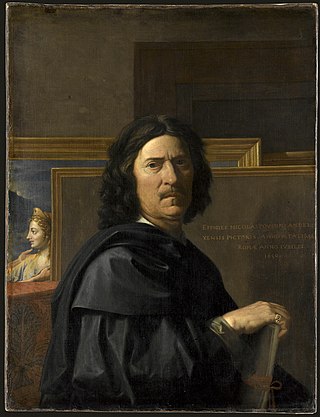
Nicolas Poussin was a French painter who was a leading painter of the classical French Baroque style, although he spent most of his working life in Rome. Most of his works were on religious and mythological subjects painted for a small group of Italian and French collectors. He returned to Paris for a brief period to serve as First Painter to the King under Louis XIII and Cardinal Richelieu, but soon returned to Rome and resumed his more traditional themes. In his later years he gave growing prominence to the landscape in his paintings. His work is characterized by clarity, logic, and order, and favors line over color. Until the 20th century he remained a major inspiration for such classically-oriented artists as Jacques-Louis David, Jean-Auguste-Dominique Ingres and Paul Cézanne.

Jean-Antoine Watteau was a French painter and draughtsman whose brief career spurred the revival of interest in colour and movement, as seen in the tradition of Correggio and Rubens. He revitalized the waning Baroque style, shifting it to the less severe, more naturalistic, less formally classical, Rococo. Watteau is credited with inventing the genre of fêtes galantes, scenes of bucolic and idyllic charm, suffused with a theatrical air. Some of his best known subjects were drawn from the world of Italian comedy and ballet.
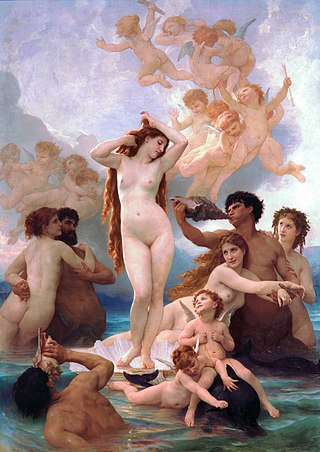
Academic art, or academicism or academism, is a style of painting and sculpture produced under the influence of European academies of art, usually used of work produced in the 19th century, after the end of the Napoleonic Wars in 1815. In this period the standards of the French Académie des Beaux-Arts were very influential, combining elements of Neoclassicism and Romanticism, with Jean-Auguste-Dominique Ingres a key figure in the formation of the style in painting. Later painters who tried to continue the synthesis included William-Adolphe Bouguereau, Thomas Couture, and Hans Makart among many others. In this context it is often called "academism", "academicism", "art pompier" (pejoratively), and "eclecticism", and sometimes linked with "historicism" and "syncretism." Academic art is closely related to Beaux-Arts architecture, which developed in the same place and holds to a similar classicizing ideal.

Nicolas Lancret was a French painter. Born in Paris, he was a brilliant depicter of light comedy which reflected the tastes and manners of French society during the regency of the Duke of Orleans and, later, early reign of King Louis XV.
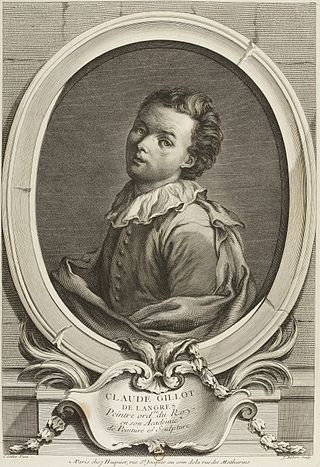
Claude Gillot was a French painter, print-maker, and illustrator, best known as the master of Watteau and Lancret.
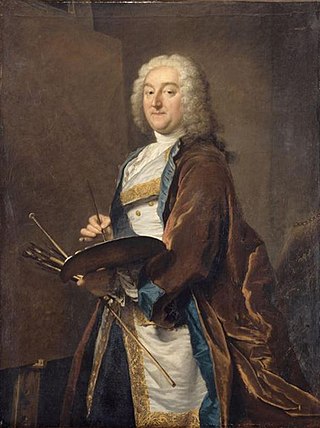
Jean-François de Troy was a French Rococo easel and fresco painter, draughtsman and tapestry designer. One of France's leading history painters in his time, he was equally successful with his decorative paintings, genre scenes and portraits. He was the inventor of the tableaux de modes, which attempted to provide a spirited portrayal of contemporary fashions, pastimes and manners.

Fête galante is a category of painting specially created by the French Academy in 1717 to describe Antoine Watteau's (1684–1721) variations on the theme of the fête champêtre, which featured figures in ball dress or masquerade costumes disporting themselves amorously in parkland settings. When Watteau applied to join the French academy in 1717, there was no suitable category for his works, so the academy simply created one rather than reject his application. His reception piece was the Embarkation for Cythera, now in the Louvre.
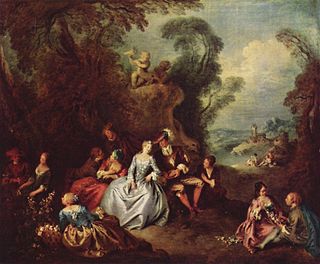
Jean-Baptiste Pater was a French rococo painter.
Pierre Max Rosenberg is a French art historian, curator, and professor. Rosenberg is the honorary president and director of the Musée du Louvre in Paris, and since 1995, he has held the 23rd seat of the Académie Française. He was Slade Professor of Fine Art at the University of Cambridge in 1987.

Roger de Piles was a French painter, engraver, art critic and diplomat.
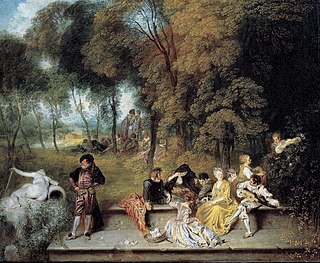
A fête champêtre was a form of entertainment in the 18th century, taking the form of a garden party. This form of entertainment was particularly practised by the French court, where in the Gardens of Versailles and elsewhere areas of the park were landscaped with follies, pavilions, and temples to accommodate such festivities.
Events from the year 1717 in art.

Trois crayons is a drawing technique using three colors of chalk: red (sanguine), black, and white. The paper used may be a mid-tone such as grey, blue, or tan. Among numerous others, French painters Antoine Watteau and François Boucher drew studies of figures and drapery aux trois crayons. The technique was, most notably, pioneered and popularised by the Flemish master Peter Paul Rubens.

The Embarkation for Cythera is a painting by the French painter Jean-Antoine Watteau.

The Country Dance is an oil painting by French artist Jean-Antoine Watteau, located in the Indianapolis Museum of Art, which is in Indianapolis, Indiana. Probably one of Watteau's earliest painting, created roughly 1706-1710, it depicts a group of quite courtly peasants dancing among the trees.

In art, a reception piece is a work submitted by an artist to an academy for approval as part of the requirements for admission to membership.

The Shepherds is a c. 1717 painting by Antoine Watteau, now in the Schloss Charlottenburg in Berlin. It is the most finished version of a composition later reused by the same artist in Pastoral Pleasure.
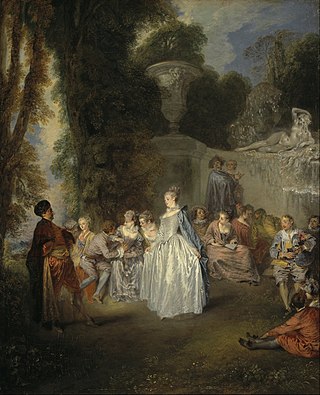
Fêtes Vénitiennes is a 1719 painting by Antoine Watteau, now in the Scottish National Gallery in Edinburgh, to which it was bequeathed in 1861 by Lady Murray of Henderland, widow of John Murray, Lord Murray. It takes its title from a 1732 engraving of the work by Laurent Cars and is derived from the Venetian styles of dress and dancing shown in the work, the former inspired by the commedia dell'arte. It belongs to the fêtes galantes genre created by Watteau.

La Boudeuse is the modern title given to an oil on canvas painting in the Hermitage Museum, Saint Petersburg, by the French Rococo painter Antoine Watteau (1684–1721). Completed in the late 1710s, La Boudeuse depicts a young couple set amidst a park in the foreground, in a rare example of the two-figure landscape composition which is considered one of the best fêtes galantes in Watteau's later work. However, the picture's authenticity was also a subject of scholarly debate, for it had been engraved by English painter Philippe Mercier, once a follower of Watteau, and was not included in Jean de Jullienne's edition of Watteau's work published in the 1730s.

The Robber of the Sparrow's Nest is an oil painting by the French Rococo artist Antoine Watteau, now in the National Galleries of Scotland, Edinburgh. Variously dated between 1709 and 1716, the painting is a pastoral scene that is one of a few extant arabesques in Watteau's art; it shows a young couple with a dog, sitting at a sparrow's nest; it has been thought to be influenced by Flemish Baroque painting, exactly by Peter Paul Rubens' painting from the Marie de' Medici cycle.
